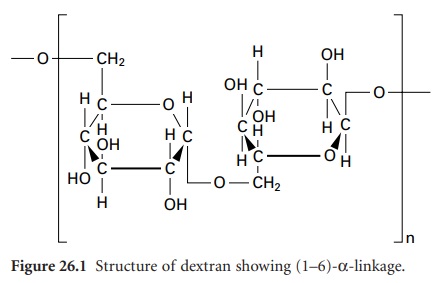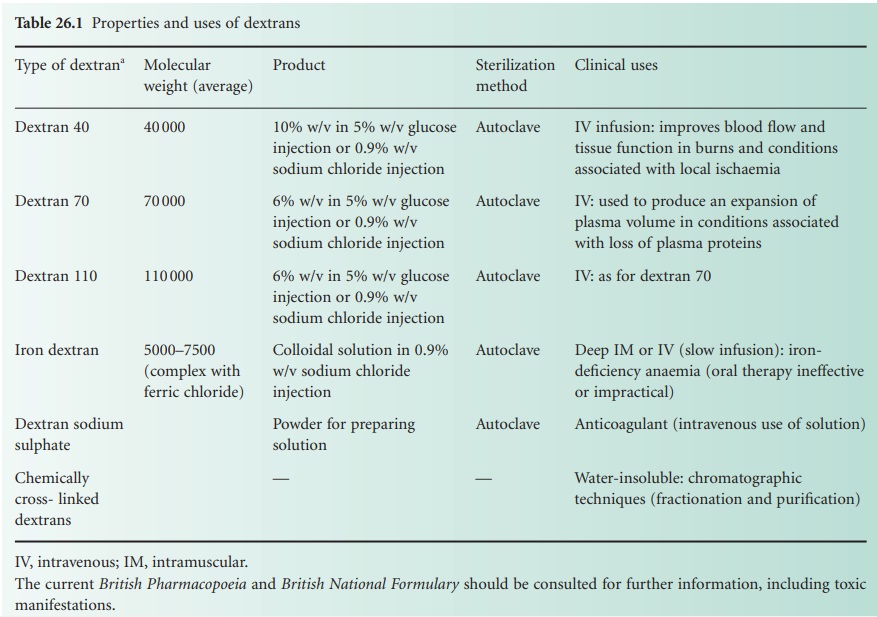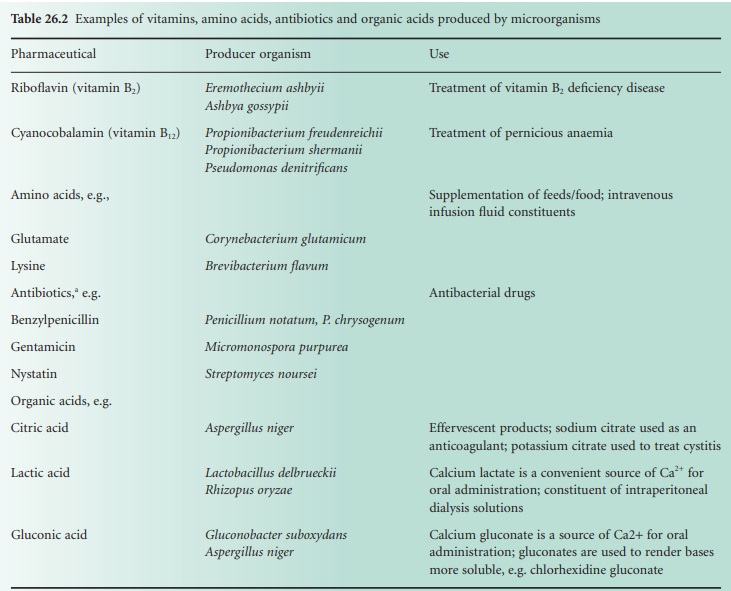Pharmaceuticals Produced by Microorganisms
| Home | | Pharmaceutical Microbiology | | Pharmaceutical Microbiology |Chapter: Pharmaceutical Microbiology : The Wider Contribution Of Microbiology To The Pharmaceutical Sciences
Dextrans are polysaccharides produced by lactic acid bacteria, in particular members of the genus Leuconostoc (e.g. L. dextranicus and L. mesenteroides), following growth on sucrose.
PHARMACEUTICALS PRODUCED BY MICROORGANISMS
A)
Dextrans
Dextrans are polysaccharides produced
by lactic acid bacteria, in particular members of the genus Leuconostoc (e.g. L.
dextranicus and L. mesenteroides),
following growth on sucrose. These sugar polymers first came to the attention
of industrial microbiologists in sugar refineries where large gummy masses of
dextran clogged pipelines. Dextran is essentially a glucose polymer consisting
of (1–6)-α-links of high but variable molecular weight (15 000–20 000
000; Figure 26.1).
Growth of the dextran producing strain is carried out in large fermenters using
media with a low nitrogen but high carbohydrate content. The average molecular
weight of the dextrans produced will vary with the strain used. This is
important, since the laboratory or clinical utility of the dextran is dependent
on a defined molecular weight. Two main methods are employed for obtaining
dextrans of a suitable molecular weight. The first involves acid hydrolysis of
very high molecular weight polymers, while the second uses small preformed
dextrans as templates for the polymerization process. These templates are added
to the culture fluid to produce dextrans of shorter chain length. Once formed,
dextrans of the required molecular weight are obtained by precipitation with
organic solvents prior to formulation.

Dextrans are produced commercially for use as plasma substitutes (plasma
expanders), which can be administered by intravenous injection to maintain or
restore the blood volume, and for application to ulcerated wounds or to burns
where they form a hydrophilic layer that absorbs fluid exudates.
A summary of the properties of the
different types of dextrans available is presented in Table 26.1.
Dextrans for clinical use as plasma expanders require a molecular weight
between 40 000 and 300 000. Polymers below 40 000 molecular weight are excreted
too rapidly from the kidneys, while those above 300 000 molecular weight are
potentially dangerous because of retention in the body. In practice, infusions
containing dextrans of average molecular weights of 40 000, 70 000 and 110 000
are commonly encountered.

In the USA, dextran injections with average molecular weights of about
75 000 are also available.
Iron dextran injection, containing a complex of iron hydroxide with
dextrans of average molecular weight between 5000 and 7000, is used for the
treatment of iron-deficiency anaemia in situations where oral therapy is either
ineffective or impractical. The sodium salt of sulphuric acid esters of
dextran, i.e. dextran sodium sulphate, has anticoagulant properties comparable
with those of heparin and is formulated as an injection for intravenous use.
B)
Vitamins, Amino Acids And Organic Acids
Several chemicals used in medicinal products are produced by
fermentation.
i) Vitamins
Vitamin B2 (riboflavin),
one of the B group of vitamins, is present in milk, liver, kidneys, cereals and
vegetables and is also synthesised by intestinal flora in carbohydrate-rich
diets. Vitamin B2 deficiency, although rare,
is characterized by symptoms that include an inflamed tongue, dermatitis and
injury to the bone marrow. In genuine cases of malnutrition these symptoms will
accompany those induced by other vitamin deficiencies. Riboflavin is produced
commercially in significant yields by the moulds Eremothecium ashbyii and Ashbya gossypii and some bacteria including B. subtilis (Table 26.2).

Pernicious anaemia is a fatal disease
first reported in 1880, but it was not until 1926 that it was discovered that eating
raw liver effected a remission. The ‘anti-pernicious’ ingredient was
subsequently isolated and called vitamin B12 or
cyanocobalamin. Vitamin B12 was
initially obtained from liver but during the 1960s it was determined that it
could also be obtained as a by-product of microbial metabolism (Table 26.2).
Hydroxycobalamin is the form of choice for therapeutic use and can be derived
either by chemical transformation of cyanocobalamin or directly as a
fermentation product.
Biotin, formerly known as vitamin H, is now regarded as another member
of the vitamin B family and is found in similar food types. Biotin acts as an
essential cofactor in chemical reactions that maintain normal metabolic
function. It is also an essential growth factor for some bacteria. Its chemical
structure was established in the early 1940s and a practical, highly
stereospecific, chemical synthesis enabled d-biotin, identical to that found in
yeasts and other cells, to be produced.
ii) Amino acids
Amino acids find applications as
ingredients of infusion solutions for parenteral nutrition and individually for
the treatment of specific conditions. They are obtained either by fermentation
processes similar to those used for antibiotics or in cell-free extracts
employing enzymes isolated from bacteria (Table 26.2).
iii) Organic acids
Examples of organic acids (citric,
lactic, gluconic) produced by microorganisms, together with pharmaceutical and
medical uses, are given in Table 26.2.
Citric and lactic acids also have widespread uses in the food and drink and plastics
industries. Gluconic acid is also used as a metal-chelating agent in, for
example, detergent products.
Related Topics
